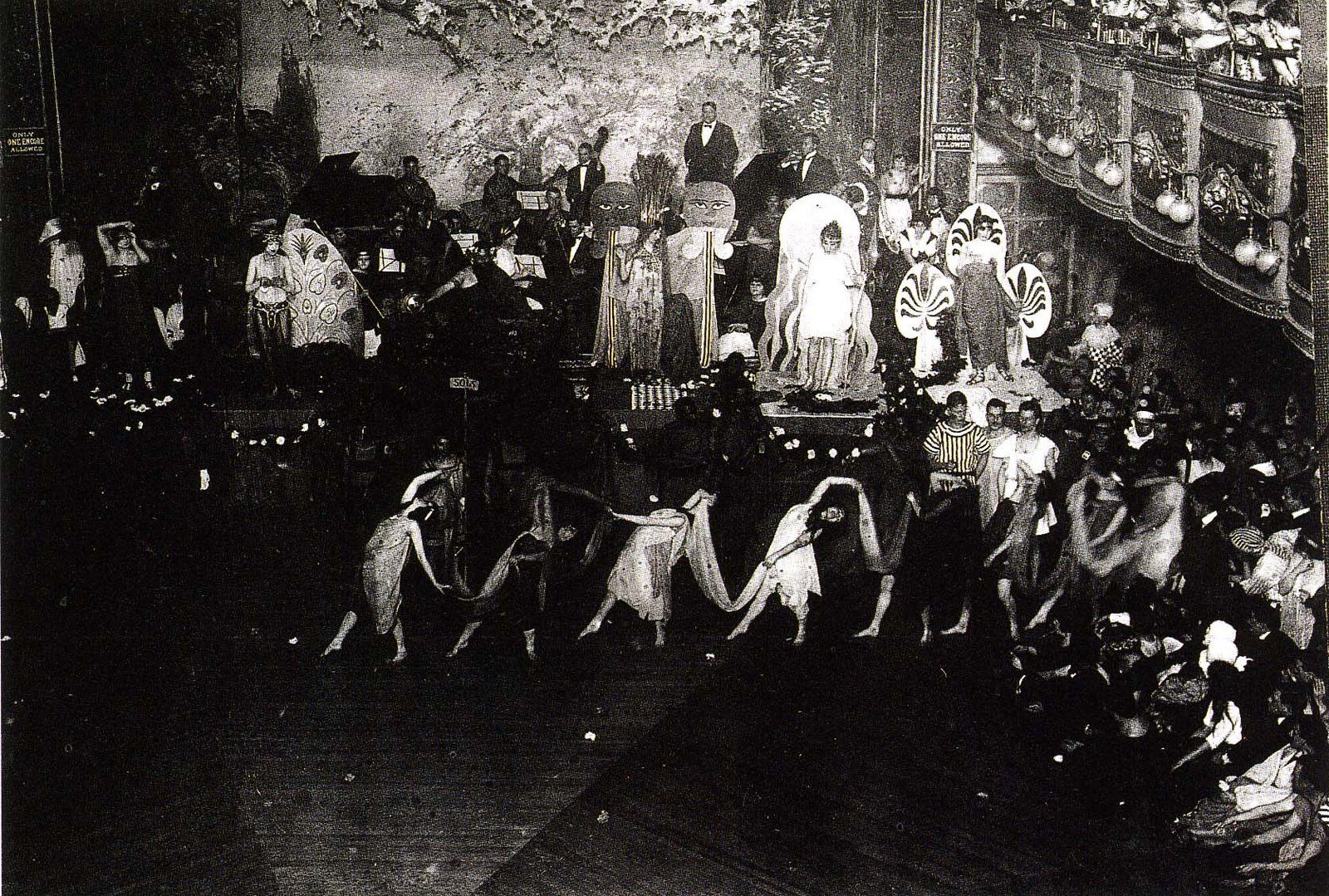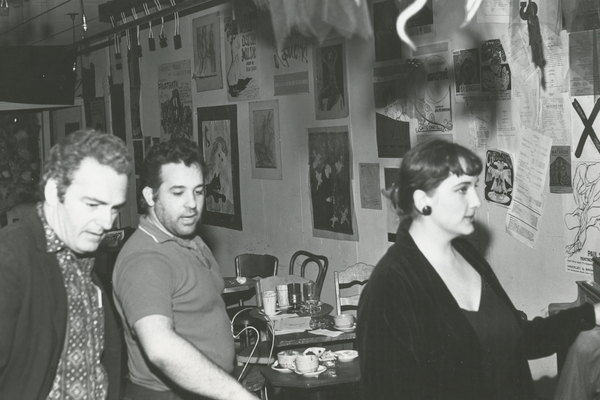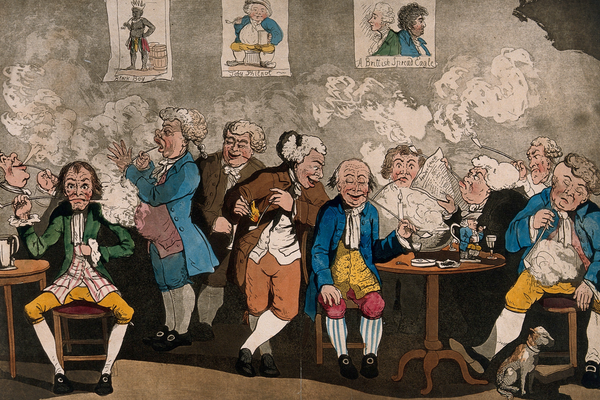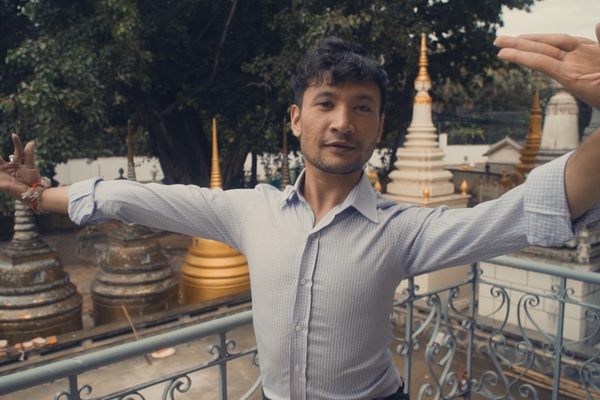In the Early 20th Century, America Was Awash in Incredible Queer Nightlife
Then Prohibition ended, and the closet was born.

The drag balls at Webster Hall attracted thousands of cross-dressing men and women. (Photo: Schlesinger Library, Radcliffe Institute, Harvard University)

In the Civic Ballroom of Hamilton Lodge of 1920s Harlem, satin heels beneath delicate gowns and feathers swept across smooth dance floors. Men who waited to take the stage adjusted their stockings, touched up their rouge. At tables nearby, women sitting together loosened their ties, drawing their hands and foreheads close. “Wigs, where necessary, were in evidence,” says The New York Age in March 1927. “From the garb of a biblical virgin…down to the very sparse attire only seen on burlesque stage of today, accentuated with feminine gesture and lingo, to say nothing of contortions of the hip, formed the make-up of these male masqueraders.”

It was only the last line that pointed at the radical nature of the event. “All’s well that ends well,” noted the Age, “The police did not find it necessary to raid.”
During the “Pansy Craze” from the 1920s until 1933, people in the lesbian, gay, bi, trans and queer (LGBTQ) community were performing on stages in cities around the world, and New York City’s Greenwich Village, Times Square and Harlem held some of the most world-renowned drag performances of the time. While dominant American society disapproved of LGBTQ people, they were very fond of their parties. “It’s pretty amazing just how widespread these balls were,” says Chad Heap, a professor at George Washington University and author of Slumming, about the era. “Almost every newspaper article about them has a list of 20 to 30 well known people of the day who were in attendance as spectators. It was just a widely integrated part of life in the 1920s and 30s.”
All of this activity existed during cultural time that, as historian George Chauncey writes in his book Gay New York, many people believe “is not supposed to have existed.” Popular belief often holds that LGBTQ rights and acceptance was a forward-moving machine beginning with the Stonewall Riots in the 1960s, but when comparing Prohibition Era acceptance versus that of the 1950s, it isn’t so. “It’s not just that they were visible, but that popular culture and newspapers at the time remarked on their visibility—everyone knew that they were visible,” says Heap.
Even smaller towns included news stories about female impersonators and drag entertainment. Many African American newspapers, from Harlem, the Pittsburg Courier, and the Baltimore African American had news about drag events on the front page.
Some of the most iconic venues in New York City—like the Savoy, the Rockland Palace in Harlem, the Astor Hotel, and Madison Square Garden—held glamorous beauty contests and performances by drag kings and queens. Thousands of men and women met at these clubs and theaters as a safe space to dress how they wanted, and find friends, lovers and partners.
Drag queens danced, musicians sang songs like “Masculine Women, Feminine Men” in clubs, and lesbians went out to dances dressed to the nines—be it in dresses or tuxes, with many famous blues songs with lyrics talking about female relationships sung by queer women of the time. A popular song called “Boy in the Boat” (a euphemism for a clitoris) says:
“When you see two women walking hand in hand. Just look ‘em over and try to understand. They’ll go to these parties have their lights down low. Only those parties where women can go.”
Men who dressed as women were often called “pansies”, while women who dressed as men were “bull-daggers” or “bull-dikers.” Chauncey notes in his book that drag performers were “likely to be presented to thousands of spectators, many of whom traveled from other cities, in some of the best-known ballrooms of the city.” Coming out was an initiation into the world of men in sequined dresses and women in white tuxes for drag performers.

Gladys Bentley. (Photo: Public Domain)
In the early 1930s drag king Gladys “Fatso” Bentley played piano and sang amazingly lewd songs and parodies using blues music and popular showtunes. Openly bisexual, Bentley often wore a white tux, a hat, and played up a “bull-diker” image with male impersonation during her act. Garber writes that Harry Hansberry’s Clam House “featured Gladys Bentley, a 250-pound, masculine, dark skinned lesbian, who performed all night long in a white tuxedo and top hat. Bentley, a talented pianist with a magnificent, growling voice.” Famous blues singers Ethel Waters, Ma Rainey and Lucille Bogan were also lesbian or bi performers at the time; Bogan’s song B.D. (Bull Dagger) Women Blues sings:
“B.D. women, they all done learnt their plan
They can lay their jive just like a natural man
B.D. women, B.D. women, you know they sure is rough
They all drink up plenty whiskey and they sure will strut their stuff”
Drag queen Francis Renault, who got his start on the Vaudeville circuit, tended to impersonate high-society women and famous historic figures, and eventually opened a club after his own name in Atlantic City. Phil Black often passed as female while dressed in drag, pulling a more conventional female look. Harry S. Franklin wore cloche hats and fur capes over his beaded dresses, with the typical thin brows and dark lips that were in vogue. At one point, drag queen Gene Malin was the highest-paid nightclub entertainer in New York.
Rather than curtail the supposed moral decay of the American people, Prohibition played a huge part in making all these fantastic parties happen. Alcohol brought people together, but Prohibition gathered them in new combinations. The Harlem Renaissance was in full effect, and white LGBTQ people found out about the clubs and societies among Harlem’s black LGBTQ performers, frequented these parties, and often became part of them. Suddenly, when everyone was on the search for newly illegal alcohol, black and white gay and lesbian life came into contact with one another and dominant society.
And for a while, dominant society loved it.
The Rockland Palace’s Hamilton Lodge could hold up to 6,000 people—and it was often packed for its annual Masquerade ball and frequent drag shows. With probably the best tabloid headline ever written, “FAG BALLS EXPOSED. 6,000 CROWD HUGE HALL AS QUEER MEN AND WOMEN DANCE.” The Vanderbilts, the Astors, and others from high society often came to watch.
These drag balls, in some form, may have come from masquerade balls combined with gay nightlife of the late 1800s. “By the 1890s there were a number of dance halls and entertainment venues in the Bowery area that had what we would now call drag entertainment,” Heap explains. While the Hamilton Lodge Ball may have begun in the 1860s or ‘70s, it probably didn’t gain a predominantly gay and lesbian presence until the 1920s. By the mid-30s, it was the largest annual ball held in New York, attracting spectators who were gay, lesbian, straight, black and white all at once.
In the clubs of Greenwich Village, the bohemian, artistic stereotype often gave cover for LGBTQ people, as did the theater district of Times Square; as outsiders, artists and theater-workers were a little more open-minded to what the dominant society believed were “deviants.” Chauncey writes that even “the most “obvious” gay men stood out less in Times Square.”

An advertisement for Francis Renault at the Brooklyn Academy of Music. (Photo: Courtesy BAM Hamm Archives)
During the Pansy Craze, the phrase “coming out”, when someone in the LGBTQ community tells larger society of their gender or sexual identity, had a different use than it does today. In the ‘20s and early ‘30s, coming out had to do with making a debut into the gay and lesbian world, and was derived from when wealthy women would “come out” formally into high society. Steven Watson in his book The Harlem Renaissance quotes Richard Bruce Nugent saying, ”You didn’t get on the rooftop and shout, ‘I fucked my wife last night.’ So why would you get on the roof and say ‘I loved prick.’ You didn’t. You just did what you wanted to do. Nobody was in the closet. There wasn’t any closet.”
Still, LGBTQ men and women were sometimes living double lives, hiding their identities from their coworkers or engaging in “lavender marriages”; legal marriages for the purpose of a “cover” (though some may have also been marriages of bisexual couples). Queer men and women who didn’t live publicly as a pansy or a bulldagger didn’t necessarily “identify” as anything in particular, even if they acted on their desires and had same-sex partners.
“They didn’t see a conflict between not being openly gay at work and sort of only being gay during their leisure time,” says Heap, adding that a person’s class was likely indicative of how you might participate in gay and lesbian culture at the time. “These were moments when working class gay men and women could more freely explore their sexuality, desires, and interests in cross dressing, but probably no doctor or lawyer is going to dress up in drag at these events, out of risk of being exposed.” Most middle and upper class gay men and lesbians sat in the upper booths at drag events among straight people, using the popularity as a cover.
There may not have been an official closet, but as indicated by the famous Stonewall riots of the ‘60s just a few decades later, the toleration of the community didn’t continue forever. Sodomy laws that had been updated in 1923 were enforced heartily, and in the ‘30s the cultural reactionary force against visible LGBTQ identities was strong. Sex-crime panic grew, and gay men and lesbians were seen as dangerous to society. Prohibition was repealed, and the New York State Liquor laws were updated to serve alcohol only in places that were “orderly”, which didn’t apparently include gay and lesbian nightclubs.

Women dressed for a drag ball at Webster Ball. (Photo: Public Domain)
“To use the modern idiom,” Chauncey writes, “the state built a closet in the 1930s and forced gay people to hide in it.” In the mid ‘30s, production codes were put into effect that restricted and prevented performances of openly gay characters in film or in theater, and in the following decades, thousands of LGBTQ people were arrested post WWII for frequenting their own clubs. Drag balls continued, with each new generation of drag performers seemingly picking up the torch as needed. Often in a smaller, more segregated form, the impetus for large groups of people to flock to one location to watch drag performances disappeared, taking much of the history of the pansy and lesbian craze performances with it.
The Pansy and Lesbian craze of the 1920s was influential, and almost surprisingly open to LGBTQ activities to the modern eye, but when presented with the information about the popularity of drag balls of the time, it’s unbelievable that knowledge of them had almost been forgotten completely. It wasn’t until the 1970s and 80s that historians examined this part of gay and lesbian life.
Now, among drag queens and kings around the country, and the roaring popularity of Ru Paul’s Drag Race, the seeds of costume and performance and identity and oppression and celebration seem more rooted than ever in the pansies and bull daggers of the early ‘20s and ‘30s. “It’s not just that there’s the moment in time that’s been forgotten, but how visible, how integrated into American nightlife, and how popular this form of entertainment was,” says Heap. “There was this new moment of possibility and flowering of nightlife that had been spectacularly forgotten.”










Follow us on Twitter to get the latest on the world's hidden wonders.
Like us on Facebook to get the latest on the world's hidden wonders.
Follow us on Twitter Like us on Facebook